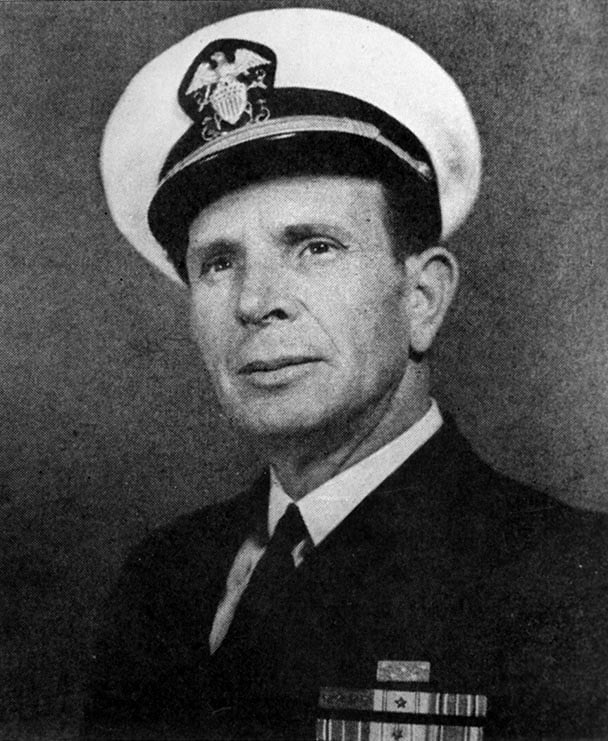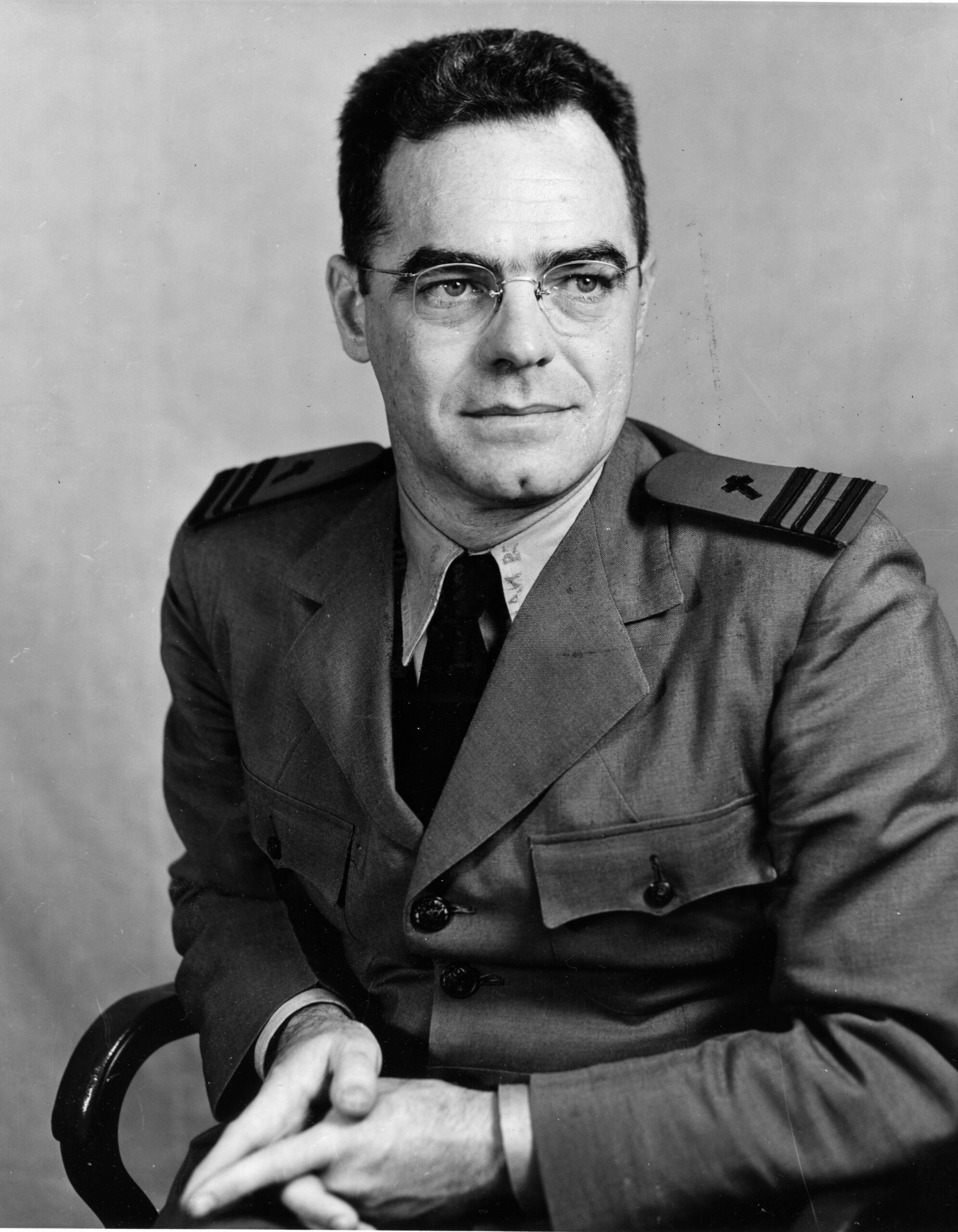Men of Faith: Medal of Honor Chaplains
By Annabel Higgins, guest author Military chaplains provide ministry and counseling to service members during both wartime and peacetime. Especially during wartime, the role of a chaplain is vital for…

By Annabel Higgins, guest author
Donald A. Gary and Joseph T. O’Callahan both came from what today could be considered large families: Gary was one of seven children and O’Callahan was one of six. Both men crossed paths during their Navy service on the USS Franklin and both ended their Navy careers with the rank of Commander. But what really ties their stories together is how each one responded heroically on March 19, 1945, resulting in both men being awarded the Medal of Honor.
The U.S.S. Franklin (CV-13), a Navy aircraft carrier, is known for enduring numerous enemy attacks and is the most damaged vessel to survive World War II.

One of its most famous encounters with the enemy occurred on March 19, 1945. The Franklin had just returned to service after repairs were needed from a Japanese attack a few months before. Now the ship was off the coast of Japan and its crew was preparing aircraft for bombing the Japanese home islands of Kyushu and Honshu. Thirty-one aircraft were fueled on the flight deck, primed with armed bombs, awaiting take-off. Another 22 aircraft were waiting in the hangar deck to follow them once the initial wave was airborne.
A single enemy aircraft dropped unexpectedly out of the clouds. The two 500 lb bombs it dropped on the USS Franklin‘s flight deck penetrated to the hangar bay, right in the midst of all that flammable fuel and primed armament. Blasts and flames filled the hangar and shot out the sides of the ship. Thick, black smoke enveloped large areas of the flight deck and the bridge. Hundreds of crewmen died where they stood or were trapped by flames and smoke. Eventually, the ship began listing in the water – anything not nailed down began shifting with the ship. Planes, armament, and equipment knocked men off their feet and blocked passageways. Injured men were everywhere.
Those still capable rushed to put out the flames to prevent further injuries or loss of life and save the ship. Despite all efforts, by the end of the day, the Franklin had lost over 800 of its men and another nearly 500 were wounded.

Donald A. Gary was born July 23, 1903 in Findlay, Ohio. He was one of seven children to parents Henry and Katherine Gary. He enlisted in 1919 at the age of 16 after only completing 1 year of high school. He served in the Philippines on different ships and after 6 years, he decided to reenlist and continue to work on the ships. He eventually received the commission of lieutenant junior grade and began work on the U.S.S. Franklin in 1944.

When the Japanese aerial attack on March 19, 1945, occurred, Lt. (j.g.) Gary risked his life to aid hundreds of sailors trapped in a compartment filled with smoke. After discovering an escape, he remained to make sure the all the sailors were able to get out of the compartment. Gary then led groups to put out fires on the flightdeck and personally went into a fireroom to direct the raising of steam in one boiler despite the danger of doing so. His courageous actions saved the lives of hundreds of sailors during the attack from the enemy. He was awarded the Medal of Honor on January 23, 1946. Ended his career as a Commander.

Joseph T. O’Callahan was born May 14, 1905, in Boston, Massachusetts. Raised in a Catholic family, he joined the Jesuits, a Roman Catholic order. He spent thirteen years of required training and education at St. Andrews College in Poughkeepsie, New York. Following his training, O’Callahan became a mathematics, physics, and philosophy professor at Boston College in Boston, Massachusetts, and College of the Holy Cross in Worcester, Massachusetts.

In 1940, he decided to enlist into the Navy Chaplain Corps as a lieutenant, just before the United States entered World War II. As the war progressed, Lieutenant Commander O’Callahan was assigned to the U.S.S. Franklin in 1945. When the ship was attacked on March 19, 1945, O’Callahan put aside his personal claustrophobia to bravely navigate the flames and exploding bombs from the attack to assist the injured and dying. He also helped to arrange teams to put out fires onboard and personally used a hose to cool down hot bombs on the deck of the ship. O’Callahan’s effort to save the lives of the crew was an inspiration to those onboard and off the Franklin.

He was awarded the Medal of Honor by President Harry S. Truman on January 23, 1946. He suffered with the wounds from his Medal of Honor actions for the rest of his life, particularly the damage done to his lungs by the smoke on the Franklin. He died young at only 58 years old.
*****
To stay up-to-date on upcoming events, special announcements, and partner/Recipient highlights, sign up to receive our monthly newsletter.
About the Congressional Medal of Honor Society
The Congressional Medal of Honor Society, a 501(c)(3) nonprofit organization, is dedicated to preserving the legacy of the Medal of Honor and its Recipients, inspiring Americans, and supporting the Recipients as they connect with communities across the country.
Chartered by Congress in 1958, its membership consists exclusively of those individuals who have received the Medal of Honor. There are 65 living Recipients.
The Society carries out its mission through outreach, education and preservation programs, including the Medal of Honor Museum, Medal of Honor Outreach Programs, the Medal of Honor Character Development Program, and the Medal of Honor Citizen Honors Awards for Valor and Service. The Society’s programs and operations are funded by donations.
As part of Public Law 106-83, the Medal of the Honor Memorial Act, the Medal of Honor Museum, which is co-located with the Congressional Medal of Honor Society’s headquarters on board the U.S.S. Yorktown at Patriots Point Naval & Maritime Museum in Mount Pleasant, South Carolina, was designated as one of three national Medal of Honor sites.
Learn more about the Medal of Honor and the Congressional Medal of Honor Society’s initiatives at cmohs.org.
